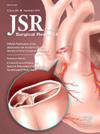Are Adolescents With Chest Wall Deformity Potential Primary Spontaneous Pneumothorax Patients?
IF 1.8
3区 医学
Q2 SURGERY
引用次数: 0
Abstract
Introduction
Chest wall deformities often become apparent with growth spurts during adolescence. Alterations in the structure of the chest wall can result in the development of pulmonary bullae and blebs, which may lead to spontaneous pneumothorax. There are limited data on this subject in the literature. In this study, it is aimed to investigate the presence of bullae and bleb in patients with anterior and posterior chest wall deformities.
Methods
Computed tomography scans of adolescent idiopathic scoliosis, pectus carinatum, and pectus excavatum patients were analyzed. The presence of bullae and/or bleb (BB) was recorded as “present” or “absent.”
Results
One hundred fifty patients with chest wall deformity have been included in the study. BB has been detected in 55 (36.7%) of the patients. Surgical procedures were performed in 45 (30%) of the patients due to chest wall deformity. BB was present in 12 (26.7%) of these patients. A statistically significant difference has been found between the presence of complications and the presence of BB in surgical patients (P < 0.001). In patients who developed complications, there was a statistically significant difference between the presence of BB and the duration of chest tube follow-up (P = 0.031), as well as between the presence of BB and the length of hospitalization (P = 0.006).
Conclusions
A significant proportion (36.7%) of patients with chest wall deformity had BB. Chest wall deformities and primary spontaneous pneumothorax (PSP) may have common etiologic factors. It should be kept in mind that patients with chest wall deformities may be potential PSP patients. Medical counseling about PSP should be considered for these patients.
有胸壁畸形的青少年是潜在的原发性自发性气胸患者吗?
导言:胸壁畸形通常会随着青春期的生长发育而变得明显。胸壁结构的改变可导致肺大泡和肺出血,从而引发自发性气胸。这方面的文献资料非常有限。本研究旨在调查前胸壁和后胸壁畸形患者是否存在肺大泡和肺出血。结果 研究共纳入 150 名胸壁畸形患者。55名患者(36.7%)发现了BB。45名(30%)患者因胸壁畸形而接受了手术治疗。其中 12 例(26.7%)患者存在 BB。在手术患者中,并发症的出现与 BB 的出现在统计学上存在明显差异(P < 0.001)。在出现并发症的患者中,出现 BB 与胸管随访时间(P = 0.031)以及出现 BB 与住院时间(P = 0.006)之间存在统计学意义上的显著差异。胸壁畸形和原发性自发性气胸(PSP)可能有共同的致病因素。胸壁变形患者可能是潜在的原发性自发性气胸患者,这一点应牢记在心。应考虑为这些患者提供有关 PSP 的医疗咨询。
本文章由计算机程序翻译,如有差异,请以英文原文为准。
求助全文
约1分钟内获得全文
求助全文
来源期刊
CiteScore
3.90
自引率
4.50%
发文量
627
审稿时长
138 days
期刊介绍:
The Journal of Surgical Research: Clinical and Laboratory Investigation publishes original articles concerned with clinical and laboratory investigations relevant to surgical practice and teaching. The journal emphasizes reports of clinical investigations or fundamental research bearing directly on surgical management that will be of general interest to a broad range of surgeons and surgical researchers. The articles presented need not have been the products of surgeons or of surgical laboratories.
The Journal of Surgical Research also features review articles and special articles relating to educational, research, or social issues of interest to the academic surgical community.

 求助内容:
求助内容: 应助结果提醒方式:
应助结果提醒方式:


